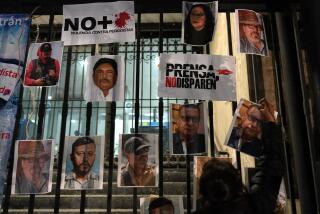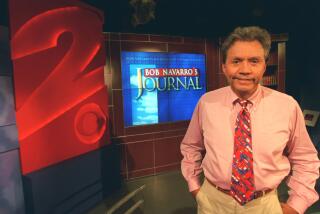Healing wounds 40 years after Ruben Salazar’s death
- Share via
In life and in death, strange things happened to Ruben Salazar.
In 1966, the legendary Times reporter found himself in Bong Son, covering the evacuation of civilians during the Vietnam War. Fellow foreign correspondent Joseph E. Brown was there with him. After three days of sleeping on the ground, the exhausted reporters landed the last hotel room in town.
Their slumbers were interrupted by the sound of refugee children outside. “Without hesitation,” Brown recalled, Salazar told the hotel owner: “Why not put them in our room?”
“And that’s how we spent the night,” Brown wrote. “Ruben and I sleeping on the hard floor and seven Vietnamese youngsters sleeping in what had been our beds.”
Like much about Salazar’s life, it’s a story tinged with irony and sadness — because just a few years after surviving the combat zones of Vietnam, Salazar was killed after stopping to use the bathroom at an East L.A. bar.
“I find it hard to believe that Ruben is gone,” Brown wrote.
I found Brown’s 1970 letter to the editor deep in the clips, that archive of cut-out stories that once filled envelopes in The Times’ library. I’d gone to those archives, now digitized, to get a little closer to Salazar on the 40th anniversary of his death.
Ruben Salazar was a city reporter and a foreign correspondent. He also enjoyed a brief but distinguished career as a columnist. It ended with his killing on Aug. 29, 1970.
After his death, schools and parks were named after him and a stamp issued in his honor. But even today there’s much about his story that leaves this Angeleno feeling unsettled.
First, there’s Salazar’s unfinished work. He was among the early chroniclers of a self-confident, assertive Latino L.A. but was killed on the day it took its biggest step toward political consciousness.
Then there are the many unanswered questions surrounding his death.
Salazar was shot in the head with a tear gas projectile fired by a sheriff’s deputy at the end of a day in which a large East L.A. protest against the Vietnam War ended in rioting. Salazar was a frequent critic of police brutality. Some in East L.A. suspected he was assassinated.
The wounds were still fresh on Sept. 3, 1970, the day The Times published an article on his funeral service. “He was not a militant,” his friend Roberto Cruz said at the service.
President Nixon sent a condolence telegram lauding Salazar, who was also the news director at Spanish-language TV station KMEX. And he also sent White House counselor Robert Finch to the funeral service.
Finch delivered a letter to Salazar’s widow saying the White House would do everything to clarify his death.
No doubt Salazar would have been amused to find the White House represented at his funeral. Like many a journalist, he’d expended a good deal of energy calling officialdom to task. And probably he wouldn’t be surprised that, 40 years later, that official promise is still unfulfilled.
He lived in the heyday of the “Chicano Power” movement. It was a phrase that appeared in his columns again and again — largely because power was something Mexican Americans lacked.
“Power, Chicano,” he wrote in an April 10, 1970, column after a frustrating visit to Washington to complain to officials about the portrayal of Latinos in the media. The Federal Communications Commission had largely ignored Salazar and his fellow Latino media professionals, treating them like “quaint” outsiders, he wrote. “Power. That’s what Washington understands.”
That must have been a radical thing to read in The Times in 1970.
“Who is a Chicano?” read the headline on Salazar’s very first offering as a columnist, on Feb. 6, 1970. A Chicano, he explained, is a Mexican American who refuses to accept a second-class brand of U.S. citizenship:
“This is why Mexican American activists flaunt the barrio word Chicano — as an act of defiance and a badge of honor.”
The young Chicano activists of the day called Salazar all the time.
Rosalío Muñoz, then a 24-year-old draft resister, complained to him in early 1970 that The Times wasn’t writing about East L.A.’s antiwar movement. “If you keep on doing what you say you’re going to do, you’ll get coverage,” Salazar told him.
Finally, on Aug. 29, 1970, Muñoz and Salazar found each other on Whittier Boulevard, among 30,000 marching people.
“He came up to me in his white guayabera and gave me a big hug,” Muñoz said. “He said, ‘You did it!’ ”
Hours later, he was dead.
In 1995, Times reporter Robert J. Lopez set out to investigate what happened. In the weeks before his death, Salazar told several people, including federal civil rights officials, that he was being followed by police.
About 5 p.m. Aug. 29, deputies arrived at the Silver Dollar Bar on Whittier Boulevard after an erroneous report that there was a man with a gun inside. The tear gas projectile struck Salazar in the temple. In his 1995 report, Lopez concluded “all available evidence” showed the slaying was “a tragic accident.”
But Lopez’s search for additional evidence was frustrated. He asked the Sheriff’s Department for its records on the case. Among other things, they might establish whether Salazar was under surveillance. Then-Sheriff Sherman Block denied his request.
Fifteen years later, Lopez is seeking the records again, from Sheriff Lee Baca.
If that request is honored, it could help heal the wounds of 1970.
In July 1970, five weeks before he was killed, Salazar praised officials for acting quickly to press charges against local police accused of shooting two unarmed men.
“In matters of human rights, there is nothing more beautiful than to see the System work,” he wrote.
It’s still a beautiful thing, even when the system kicks into action 40 years after the fact.
More to Read
Sign up for Essential California
The most important California stories and recommendations in your inbox every morning.
You may occasionally receive promotional content from the Los Angeles Times.










